The Eternal Flame
Über das Versprechen der Ewigkeit
10.8. —
5.10.2008
‘Eternity’ is one of those words we use without really having a concept of what they refer to. As an existential experience of our life-time and a metaphysical idea of something ‘beyond time’, our relationship with time is a philosophical evergreen.
The Greek philosophers Plato and Aristotle always assumed that matter existed eternally when discussing the big mystery of how the world came into being. They did not believe that the world as known by humankind could simply have materialized out of nothing. On the threshold from antiquity to the Middle Ages, the theologian and philosopher Augustine considered eternity to be an everlasting force and even called it a negation of all time. In subsequent centuries, theologians and philosophers often understood eternity to mean there was hope for the existence of God. Henri Bergson, in the 19th century, and Martin Heidegger, in the 20th, however, had other, more modern difficulties with the notion of eternity. Bergson was particularly concerned with the precarious shortcomings of language to even describe eternity, while Heidegger tried to find eternity in art, for instance — in order to make the unimaginable more graspable. The point where language and the aesthetic experience of art intersect seems to be propitious for reflections on eternity. At the juncture where space-time orientation seems to dissolve, we can start thinking about eternity. Although the dimensions of eternity are almost impossible to imagine, they can still somehow be experienced by the individual. That paradox is the point of departure for this exhibition, and it is reflected in the work of contemporary artists moving between the idiom of abstraction and landscape motifs – two of the most important pictorial languages of modern art that make reflections on eternity conceivable. Claudia Wieser, for instance, combines both levels when she adds a geometrical shape in silver leaf to printed photographs of impressive mountain-scapes taken from 20th century travel literature (Kessel der 5 Seen, 2007). One could be tempted to consider the silver shape as a token of how forms continually develop in nature. What lies between the idea of eternity and the organisation of time in our daily lives? The question of the interstitial spaces in images, language and time sequences is explored by the Belgian artist Kris Martin. A life-size mirror bears the inscription THE END in mirror-inverted curved letters. The mirror shows the room in retrospect together with the viewer. The inscription, with its pathos reminiscent of old movies, adds a temporal layer to the spatial mirror image. Factually, space-time ends at this mirror wall; for the viewer, however, it is right there that an illusionary space begins combining language and the mirror image. In the film Starfield (2004), Jordan Wolfson lets a dot develop into a line that seems to continue eternally. Although this is only a simple version of the old Starfield screensaver, you could also see this abstract film as a possible depiction of infinity and eternity. In the perspectival illusion of the film, the lines appear to be parallel; when viewing the animation as a two-dimensional image, however, the lines converge and might actually meet. This would mean the fulfilment of the mathematical axiom of ‘parallel lines meeting at infinity’. Quantum physicists also speak about a continuous present that makes do without any fact-creating action. According to the British philosopher Colin McGinn this is merely a ‘phase of potentiality’. We are as unable to conceive of eternal duration as of present transience. And yet we at least have a linguistic concept of ‘eternity’ that enables us to use it in statements. Let us try to put it this way: although eternity is not imaginable, it is still possible. And particularly at the boundaries of aesthetic experience — in the work of certain contemporary artists, for instance — this possibility becomes conceivable.
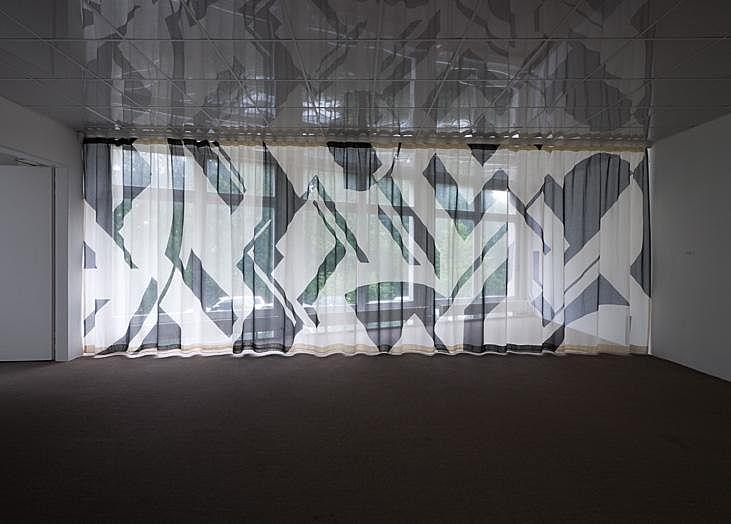
The works of Eva Berendes (b. 1974 in Bonn, lives in Berlin) emerge from the artistic exploration of both historic and contemporary formalistic movements. The geometrical compositions in her paintings, sculptures, reliefs and installations are reminiscent of previous approaches to abstraction, including Russian Suprematism, Constructivism or Art Deco, but also the architectural and creative achievements of the Bauhaus period. Her curtain installation in the Gallery Room of the Kunsthaus Baselland represents a reformulation of the conception of space. Although slowed down, the flow of light through the room is not entirely blocked. Standing in formal correspondence with this installation is the wall sculpture. With its prominent web of woollen threads spanning between bamboo poles, it elicits associations with a harp. The style of Eva Berendes’ work is marked by the interplay of shapes, colours and spatial intertwining and carries the aesthetic forms of Modernism into the present day.
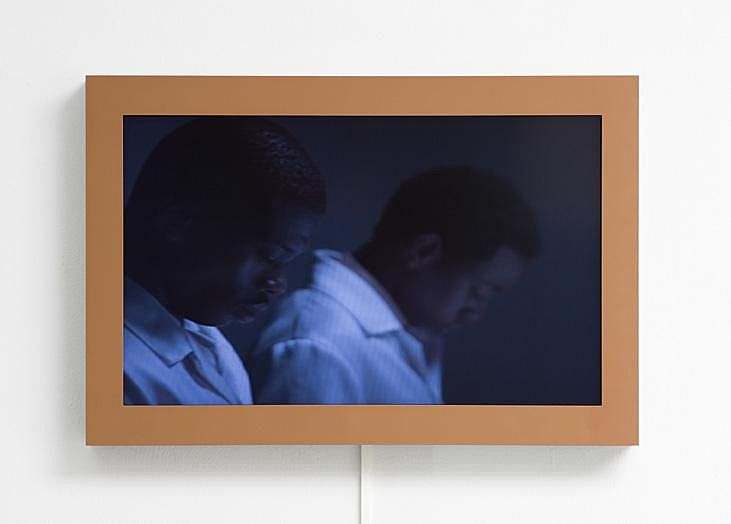
Michaël Borremans (b. 1963 in Geraardsbergen, lives in Ghent) has become noted mainly for his enigmatic paintings and drawings which make reference to imagery taken from theatre, cinema and the sciences. In parallel to his drawing, Borremans began to experiment with the medium of film. The outcomes from this endeavour were first exhibited in 2007 in the Amsterdam art centre De Appel. His films are closely linked to his paintings and drawings and might even be considered as tableaux vivants. His film The Feeding (2006) is related to his painting The Appearance (2005). It shows a group of men performing an unspecified ritual, eliciting associations with evocations of nirvana or invocations of deities. The hands of the men, dressed in white like doctors or scientists, seem to make the white surfaces levitate — or is it them who draw energy from the objects? The film does not provide definite answers. Instead, it plays with its ubiquitous state of visual and thematic levitation. Once built up, the suspense remains uniform, denying itself a climax.
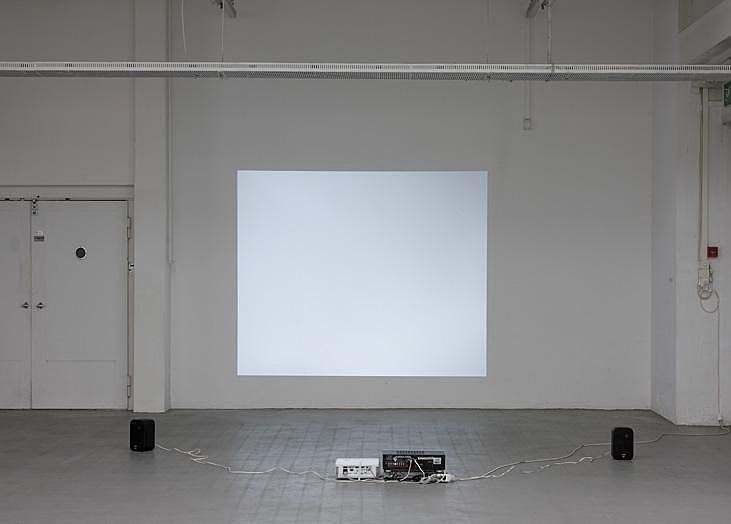
The works of Steve Van den Bosch (b. 1975 in Antwerp, lives in Rotterdam) range between conceptual and performance art and staged installations. Simultaneously centred upon their own emergence and their possible interpretation in an exhibition context, the works explore the shifts in light and colour which link up pictorial qualities with the dramaturgy of a piece of architecture. Van den Bosch describes how the exhibited work came into being: “At the end of 2006 I began recording white walls during visits to renowned galleries in New York — Marian Goodman, Gavin Brown’s enterprise, Baumgartner, etc. After I realised this wasn’t allowed I had to act like a regular visitor to be able to make the recordings, which made the whole idea more interesting. Because there wasn’t just the shift from context to exhibit and the other way around, created by the gallery itself, but it also forced me to engage in several performances which were — necessarily — unnoticed by the audience, in this case the venues’ staff.”
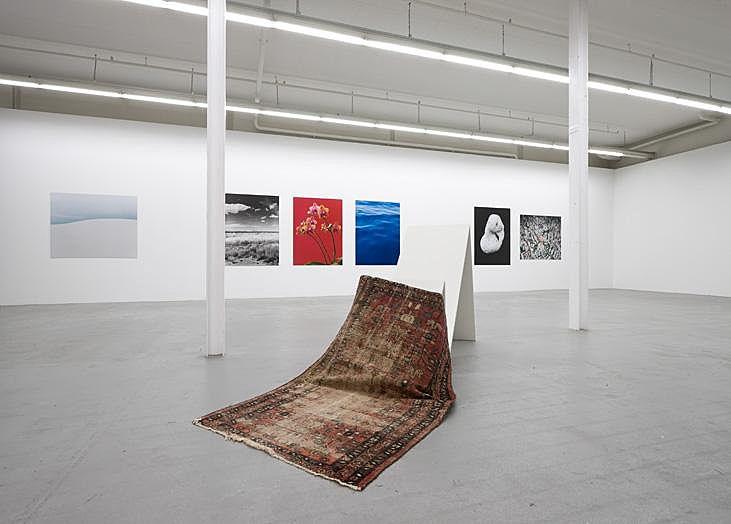
With the exploration of Minimalism as the point of departure, the works of Tom Burr (b. 1963 in New Haven, Connecticut, lives in New York) do not only feature the characteristics of Minimalism, but also its weakness, the ‘theatricality’, as criticised by the art historian Michael Fried in the 1960’s. His sculptures approximate pieces of furniture and everyday objects, but also the human figure, as their system of reference. Despite the theme of the prefabricated, the objects’ flexible postures are reminiscent of human positions and moods. Their instability and transportability make them appear mobile and alterable. Burr tends to complement his sculptures with everyday objects such as books, glasses or, as in his currently exhibited work, a threadbare oriental rug to heighten the evocation of a certain mood. The eternal theme of human moods in the arts, but also the rejection of this theme in the art critique offered by post-war modernists, take special shape in Burrs works.
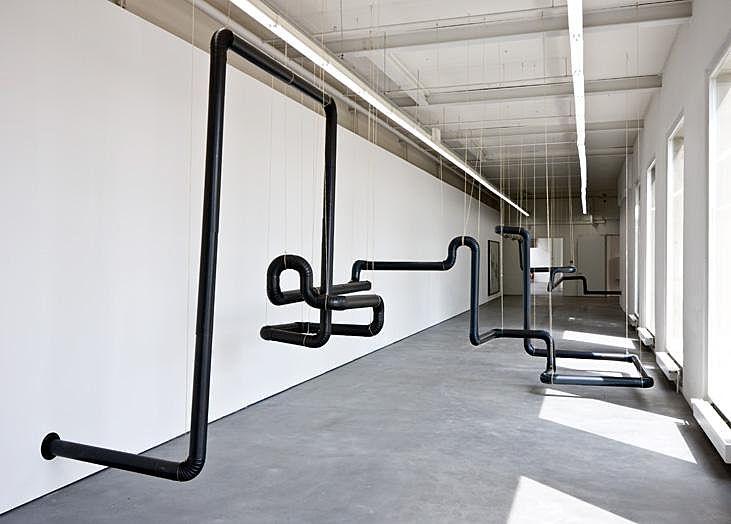
The installations, drawings, paintings and photographs of Friedrich Kunath (b. 1974 in Chemnitz, lives in Cologne and Los Angeles) are often associated with melancholy, the absurd and sometimes the slightly surreal. His works speak of moods and the all-too human. Despite their highly emotional content, they adhere to strict conceptual principles of construction. This is also reflected in the exhibited work. The pipe of a stove in the entrance area appears to cut its path right through the wall to meander its way out of the next room, forming a highly complex stovepipe system. Just like someone who, out of sheer absurdity, decides to divert an object from its intended use and follows his or her impulse for action even though it does not make sense. Besides this very human trait, the theme of Kunath’s installation touches upon the general concept of networks: networks which include and/or exclude everyone — the notion of being inside and outside, similar to the pipes which seem to meander through different space and time continuums. The accompanying drawing depicts an agglomeration of mathematical formulas, like scribbles of a genius, which end in the digit zero. Does everything eventually lead to vacuousness? Does zero equal vacuousness or is zero an abstraction, just like the calculation itself? Where is the beginning and where the end? Kunath’s installation seems to be located in a space-time arrangement in which permanent hovering, rising and falling leads to eternity.
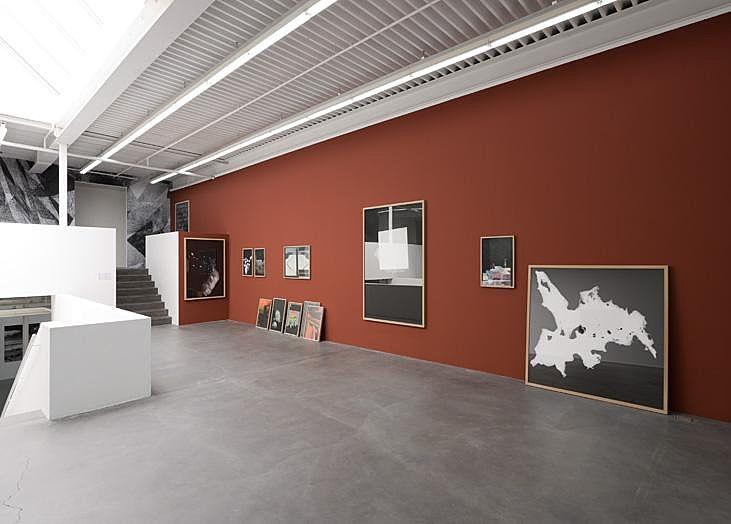
The exhibits of Fabian Marti (b. 1979 in Fribourg, lives in Zurich) are taken from two different groups of works arranged in a new form for The Eternal Flame. A series of large-sized scans of metal and mineral fragments are surrounded by some smaller works depicting front pages of story papers. For both types of work, Marti used a special scanning technique where the cover of the scanning device was removed. This created the deeply black backdrop of the pictures which plays with the possibility of a boundless background. At the same time, the enlarged metal and rock formations emerge as an almost exaggerated presence in the foreground. Depicted are materials which speak of moral concepts and meanings we might attach to rocks, metals or images in nature: the crystalline structure of a mineral as the organising principle, a flowing metallic shape, the copy of a Caspar David Friedrich motif of a ruin. By showing the bust of an ancient thinker from the angle of the base bottom, Marti reduces a meaningful object to its footprint and an intimate perspective of the nostrils. The objects as well as their meanings or philosophical and historical dimensions obtain a potentially unlimited background.

In his installations, drawings and performances, Kris Martin (b. 1972 in Kortrijk, lives in Ghent) looks into the relationships between observer, depiction and concepts of time. In this exhibition, the visitor meets a mirror work which, at its front face, provides a life-size reflection of both visitors and the room with a change in the reflected image that is minor but effective: in a flowing font and mirror-inverted, the mirror reads THE END. This solemn ascertainment of the end, recognisable from old films, adds a temporal dimension to the spatial mirror image. While space-time in fact ends with this mirrored wall, the cross-fading of language and mirror image marks the beginning of an illusionary room for the observer. Is this mirror the threshold to the projection room of an imaginary film projector? Only one scene is shown under the laconic header THE END: the mirror image of the group exhibition with the visitors as the protagonists.
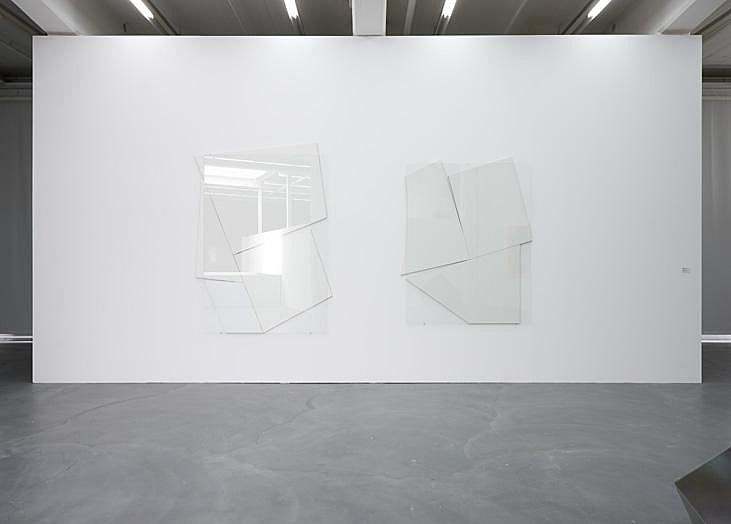
“Whether they be small-sized objects or large installations, the works of Edit Oderbolz (b. 1966 in Stein am Rhein, lives in Basel) accrue from an almost self-indulgent affection for materials and objects whose eras of general appreciation often date back years or decades” (Isabel Zürcher).The picture arrangements of chipboard behind glass tell of this approach to recyclable materials. The interfaces of the geometric shapes point out the ‘traces of injury’ the materials have suffered. They complement each other to form a geometric composition which, at the various blank spaces, also integrates the wall as the supporting structure. The different shades of white bear witness to the distinctive contexts the materials were originally used in, where different degrees of exposure to sunlight brought about subtle variations in hue. The attempt at preserving the underlying materials by placing glass plates over them appears almost ironic. While the plates give the impression that they try to protect what lies beneath, they themselves become an integral part of the composition — the notion of protecting and preserving is taken ad absurdum.
The work of Florian Pumhösl (b. 1970 in Vienna, lives in Vienna) traces the visual grammar of shapes of historical artefacts in architecture, design and the arts. He mainly broaches the question of a potential translation across cultural spaces and temporal levels. The 16mm film OA 1979-3-5-036 is an artistic transfer of abstracted shapes taken from Dress Patterns for Noble Ladies, a formerly highly popular Japanese pattern catalogue from the 17th century. The pattern designer, the kimono tradesman Take Hiratsugi, drew his inspiration from landscape motifs, floral shapes and architectural details. Pumhösl uses simplified representations of selected designs for his 16mm film in negative form. The title, with its initially cryptic appeal, marks the cultural transfer of the pattern catalogue from its former oriental context to the library of a British art historian and eventually to the collection of the British Library. The title of the film is the catalogue’s inventory number.
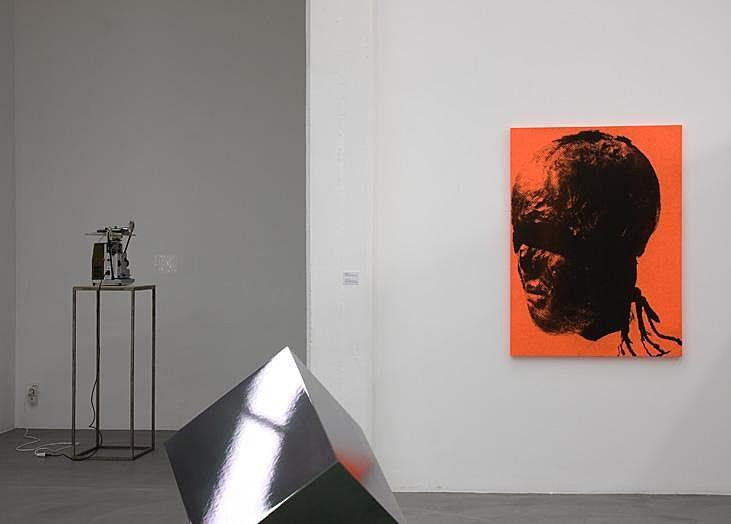
British artist Damien Roach (b. 1980 in Bromley, Kent, lives in London) often uses picture material he accidentally comes across. His focus lies on how these finds may be interpreted and what stereotypical associations they may trigger when looked at from today’s perspective. The facial expression of the 1,000-year old bog body, for instance, which Roach has printed on a canvas in screaming red. Mouth half-open, eyes blindfolded; it proves difficult to decipher the gestures after all this time. There might be religious or ritualistic reasons for the particular state the head is in, or it might even have belonged to the victim of a crime. Roach arranges a rotating cube with his screen print. During its continuous motion, the cube reflects the surrounding works, the incident light and the visitors. Has anything changed during one rotation? The mirroring object makes time-lags palpable and at the same time reflects the invariables of the room.
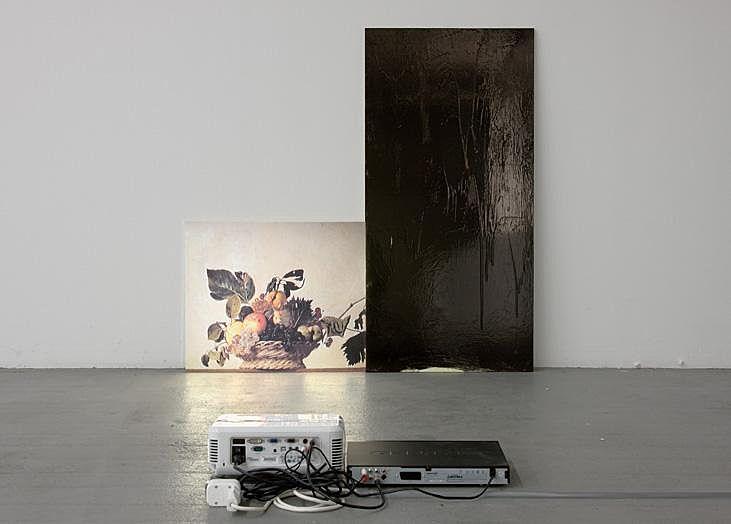
Hagar Schmidhalter (b. 1968 in Raron, lives in Basel) uses picture materials and image carriers as raw materials for her drawings, collages, videos and installations. These materials often originate from reproduction processes. Newspapers for instance, stuck together and coated with silver paint, become a curtain painting. The metallic pattern of the surface links the historic discussion surrounding the monochrome painting to the question of a narrative momentum which stands in stark contrast with the historical model. Permitting pattern and gesture and placing compositional elements play a vital role in Schmidhalter’s artistic decision-making. A depiction of Caravaggio’s Still Life with a Basket of Fruit served as starting material for her film and was reinterpreted by means of an animation. A leaf peels away from the painted arrangement and lands in an almost central position, detaching a grape which in turn falls out of the painting. The supposedly eternal ‘nature morte’, the still life captured for eternity, is revived, and the revival is in turn eternalised in the perpetuated video loop. Schmidhalter recycles materials taken from everyday life, picture archives or art history. Her work revolves around the eternal re-usability of all existing things which draw their presentness from their own disintegration and recreation.
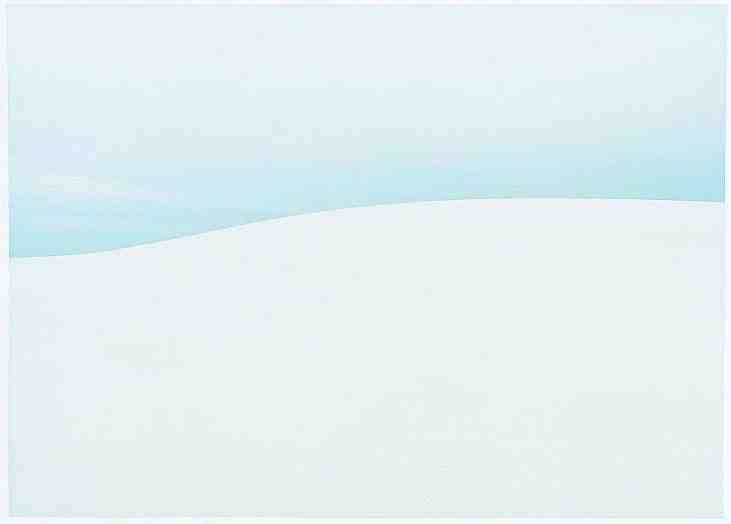
Vast landscapes, corals or a top view of an architectural model — in the photographs of Shirana Shahbazi (b. 1974 in Tehran, lives in Zurich) motifs like these seem to become archetypes of the history of civilisation. One might be looking at a series of cultural monuments. The monochrome colouring or backgrounds in some of her works give the motifs an almost exemplary character: a blossom shown against a red backdrop, a water surface depicted in intense shades of blue. Even though the titles provide information on the place, the date and the group of works each photograph belongs to, thus making it possible to retrace the photographic production process, the motifs act upon the observer like beacons with an almost time-transcending presence. The visitor’s eye is caught immediately by their conspicuousness and exemplary qualities, which is why the motifs, stemming from completely different cultural and geographical contexts, may open up plenty of room for productive misunderstandings. While the places where the landscape photographs were taken at a very precise moment in time are indicated in each title, they are virtually deprived of their roles as identifiers of the unique. They might be considered as the typical landscape photographs instead. For exhibitions, Shahbazi keeps composing new combinations of works taken from different groups, pointing out possible interpretations of the ‘archetypes’ and the reception history of the genre.

Claudia Wieser (b. 1973 in Freilassing, lives in Berlin) overlays nature, architecture and geometry when she adds a geometrical silver-foil shape to prints of impressive mountain sceneries taken from 20th century travel literature. One is tempted to understand the silver shape as the architectural principle underlying the genesis of the shape in nature, like a diagrammatic plan constructed upon a geometrical formula. In so doing, Wieser echoes artists such as Karl Blossfeldt and architectural theorists such as Siegfried Giedion who tried to decrypt nature’s ‘eternal pattern of construction’ on an aesthetic level. Wieser also exhibits two wall-covering works which have an impact on the exhibition on an architectural level. They are based on enlarged details of contemporary collages which hang in the entrance hall of the Kunsthaus Baselland. Seen from a distance, the fractal structures seem to suggest a spatial dimension following constructivist design approaches. On closer examination, however, the spatial constructions fade into the coarse grid of the copied pages. Wieser’s murals open up the group exhibition with a spatial foreshadow and anticipate at the same time the fragmented room structure of the exhibition which extends in different directions and at different levels.

In his 16mm film Starfield, Jordan Wolfson (b. 1980 in New York, lives in New York) animates bright dots travelling eternally against a dark backdrop. It may evoke visions from outer space taken from science-fiction productions in which the gaze of a starship traveller wanders across space. In point of fact, however, it is merely a version of the Starfield screensaver which was popular in the 1990’s. The film might also be considered a potential depiction of infinity and eternity. In the illusion of perspective the film creates, the orbits of the stars appear as parallel lines. However, when considering the film as a two-dimensional snap-shot, the lines converge and might eventually meet. The mathematical axiom of ‘parallel lines intersecting in infinity’ becomes a possible scenario. Wolfson’s works often trigger ideas of infinite spaces and time domains or unlimited possibilities and powers. In his visual worlds, such options seem almost within grasp; a window to new dimensions seems to open itself to the observer. In his latest work, End of Time, Wolfson interviews a man who claims to have first-hand experience of time travel. Al Bielek holds to have been sent on such a trip in the past and returned with tales of astounding adventures from the future. However, instead of showing a mere documentary of this encounter, Wolfson fades out the interview with the time traveller to focus on the genesis of his own work. On two parallel video tracks we join a protagonist on a sheer endless boat-ride. Neither departure nor arrival are shown. On the audio track we hear a phone conversation between Wolfson and a fellow artist in which they discuss possible ways of presenting the work in an artistic context. Is it at all credible to give accounts from the future? The role of the witness remains a fiction.
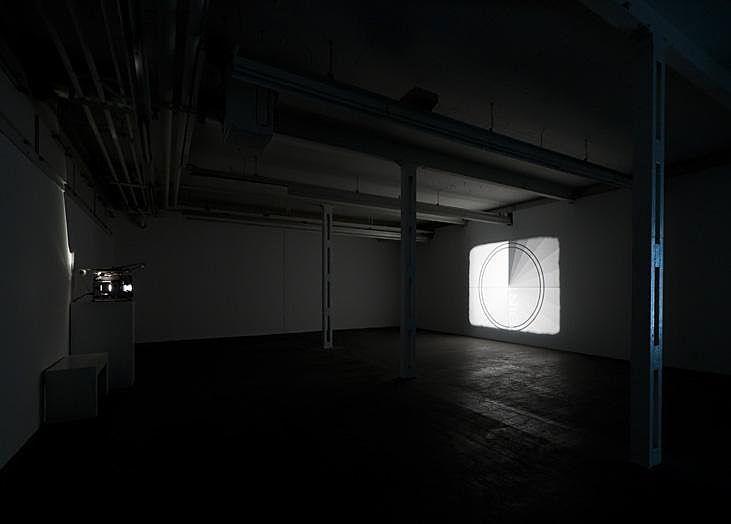
Philippe Decrauzat (b. 1974 in Lausanne, lives in Lausanne) uses forms, motifs and topics from film and art history, graphic design, architecture, literature and music. Not only does he appropriate them, he goes further and constructs a wide network of references. His film A Change of Speed, A Change of Style, A Change of Scene Part II draws together the worlds of popular science fiction entertainment, experimental film art and scientific research. On the one hand, Decrauzat makes reference to expeditions in which seeing a foreign world was considered synonymous with conquering it, like those featured in the late 1950’s US TV series The Twilight Zone. On the other hand, the tradition of the flicker film and the pulsar rhythm, the frequency of which was decoded in the 1960’s, form an important starting point for this work. “It is all about an increasingly frenetic pulsation which ultimately leads to the inability to see.” (Katya García-Antón and Bice Curiger)